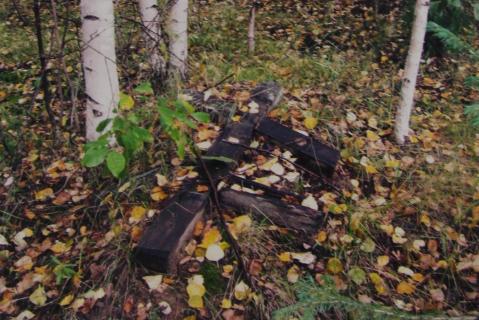Ichet-Di was set up on 17 July 1931 by dekulakized peasant families deported from central black-earth districts of Russia (a total of 1,712 people). By June 1933, 489 of these men, women and children had died of scurvy. The settlement was officially closed in 1961.
From the mid-1990s onwards, the children and grandchildren of the forced settlers began to visit Ichet-Di. A guesthouse and chapel were built on the bank of the river Pechora, and the settlers’ graveyard was cleared and tidied. In 2007 the graveyard was investigated by an expedition from the Troitsko-Pechorsk district museum of history and local studies; in that same year a memorial was erected to the founders of the village.
Repentance: the Komi Republic Martyrology of the Victims of Mass Political Repression (11 vols. 1998-2016), includes entries on 65,000 individuals, from dekulakized peasant families and former Polish citizens to Soviet German forced labourers, who were deported to the area.
The Memorial online database (2025) lists 129,473 victims in the Komi Republic. (See Nizhny Chov.)
The database records many families from the Central Black Earth and Voronezh Regions who in 1930 and 1931 were deported to Ichet-Di, 790 accused of being “kulaks”; 171 of the 1,098 individuals it names were born there.
| Date | Nature of ceremonies | Organiser or responsible person | Participants | Frequency |
|---|---|---|---|---|
|
Summer
|
Commemorative visits
|
Former inhabitants and their descendants
|
Annual event
| |
|
Tours & exploratory investigations
|
Pokayanie (Repentance) Foundation
|
Periodically
|
| State of burials | Area | Boundaries |
|---|---|---|
|
Some headboards have survived; burial mounds and typical depressions in the soil
|
not established
|
not delineated
|
[ Original texts & hyperlinks ]
G.F. Dobronozhenko and L.S. Shabalova (Compilers), Special settlements in Komi. The June 1933 comprehensive study: A collection of documents, Syktyvkar, 1997
“Report on exploratory-historical work in the Troitsko-Pechorsk district of the Komi republic” (Manuscript), Troitsko-Pechorsk, 2007
A. Nikolayeva, “The sad anniversary of a small island”, Respublika (Syktyvkar), 15 July 2011
*
Reply No 06-17-1230, 30 April 2014, from the Komi Republic Ministry of Culture to a formal enquiry by RIC Memorial (St Petersburg)


